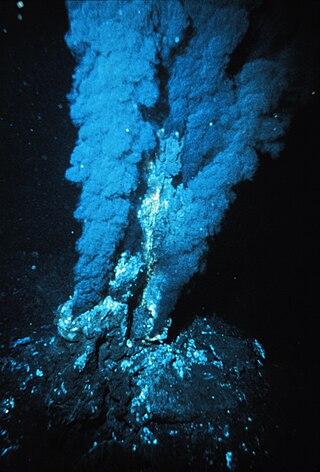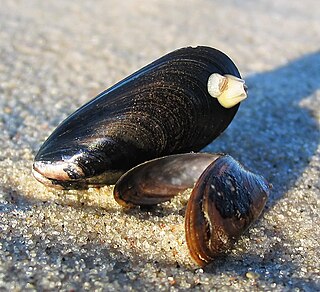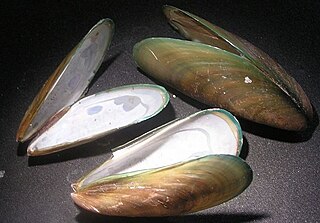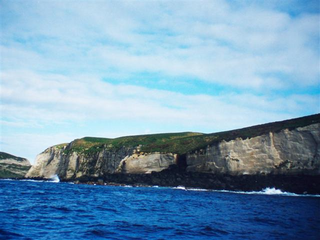
Hydrothermal vents are fissures on the seabed from which geothermally heated water discharges. They are commonly found near volcanically active places, areas where tectonic plates are moving apart at mid-ocean ridges, ocean basins, and hotspots. Hydrothermal deposits are rocks and mineral ore deposits formed by the action of hydrothermal vents.

A cold seep is an area of the ocean floor where hydrogen sulfide, methane and other hydrocarbon-rich fluid seepage occurs, often in the form of a brine pool. Cold does not mean that the temperature of the seepage is lower than that of the surrounding sea water. On the contrary, its temperature is often slightly higher. The "cold" is relative to the very warm conditions of a hydrothermal vent. Cold seeps constitute a biome supporting several endemic species.

Mytilidae are a family of small to large marine and brackish-water bivalve molluscs in the order Mytilida. One of the genera, Limnoperna, even inhabits freshwater environments. Mytilidae, which contains some 52 genera, is the only extant family within the order Mytilida.

Mytilida is an order of marine bivalve molluscs, commonly known as true mussels. There is one extant superfamily, the Mytiloidea, with a single extant family, the Mytilidae.

Lithophaga lithophaga, also known as date shell or date mussel, is a species of Bivalvia belonging to the family Mytilidae.
Gigantidas gladius is a species of large, deepwater, hydrothermal vent mussel, a marine bivalve mollusc in the family Mytilidae, or mussels.
Gigantidas horikoshi is a species of large, deepwater, hydrothermal vent mussel, a marine bivalve mollusc in the family Mytilidae, the mussels.

Bathynerita naticoidea is a species of small sea snail, a marine gastropod mollusc in the family Neritidae, the nerites. This species is endemic to underwater cold seeps in the northern Gulf of Mexico and in the Caribbean.

Bathymodiolus childressi is a species of deepwater mussel, a marine bivalve mollusk species in the family Mytilidae, the mussels.

Bathymodiolus is a genus of deep-sea mussels, marine bivalve molluscs in the family Mytilidae. Many of them contain intracellular chemoautotrophic bacterial symbionts.

Bathymodiolus thermophilus is a species of large, deep water mussel, a marine bivalve mollusc in the family Mytilidae, the true mussels. The species was discovered at abyssal depths when submersible vehicles such as DSV Alvin began exploring the deep ocean. It occurs on the sea bed, often in great numbers, close to hydrothermal vents where hot, sulphur-rich water wells up through the floor of the Pacific Ocean.
Calyptogena magnifica is a species of giant white clam found clustered around hydrothermal vents at abyssal depths in the Pacific Ocean.

Mytilus unguiculatus, common name the Korean mussel or the hard-shelled mussel, is a species of mussel, a marine bivalve mollusc in the family Mytilidae. This species is heavily exploited as a food item via mariculture in Korea and in China. It is also a typical macrofouling organism.
Gigantidas coseli is a species of large, deepwater, hydrothermal vent mussel, a marine bivalve mollusc in the family Mytilidae, the mussels. This species is endemic to the waters of the Bonin Islands of Japan.

Bathymodiolus marisindicus is a species of deepwater hydrothermal vent mussel, a marine bivalve mollusk species in the family Mytilidae, the mussels. This species is found in the Indian Ocean.

Gigantidas tangaroa is a species of deep-sea mussel, a marine bivalve mollusk in the family Mytilidae, the mussels.

Arcuatula senhousia, commonly known as the Asian date mussel, Asian mussel or bag mussel, is a small saltwater mussel, a marine bivalve mollusk species in the family Mytilidae, the mussels. Other common names for this species include: the Japanese mussel, Senhouse's mussel, the green mussel, and the green bagmussel. It is harvested for human consumption in China.

Macauley Island is a volcanic island in New Zealand's Kermadec Islands, approximately halfway between New Zealand's North Island and Tonga in the southwest Pacific Ocean. It is part of a larger submarine volcano that features a 10.5 by 7 kilometres wide underwater caldera northwest of Macauley Island. Two islets, Haszard Island and Newcome Rock, lie east offshore of Macauley Island. The island is mostly surrounded by high cliffs that make accessing it difficult; the inland parts are mostly gently sloping terrain covered with ferns and grasses.

Xenostrobus is a genus of saltwater, brackish water and freshwater clams, marine bivalve molluscs in the subfamily Xenostrobinae of the family Mytilidae, the mussels.














